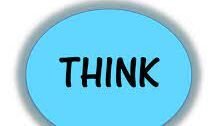
Why THINK matters
Often, our personal lives spill over into our professional lives. My personal life can be much different than my professional life however I possess tools in my personal life that I also integrate into my professional life and one of them is the acronym THINK.
I first learned this acronym in a support group many years ago. Interestingly, not until recently did I discover the value of THINK in my professional life.
When to use THINK
I have found THINK to be most useful when important communication is at stake. When you need to break bad news, asking for a raise or promotion, ending a relationship, confronting a co-worker, etc. Lets break it down and see how it works and learn how to use it.
Effective communication is the cornerstone of any successful workplace. Misunderstandings, conflicts, and inefficiencies often arise when communication breaks down. THINK stands for True/truthful, Helpful, Inspiring, Necessary, and Kind. By applying these principles to your conversations, emails, and meetings, you can improve collaboration, build stronger relationships, and create a more positive work environment.
T – True/Truthful
Before speaking or sending a message, ask yourself: Is this true? Sharing accurate information is critical in a professional setting. Misinformation, whether intentional or accidental, can lead to poor decision-making, wasted time, and even damage to your credibility. If you’re unsure about the facts, take the time to verify them before communicating. Additionally, being truthful means being honest about your thoughts and feelings while remaining respectful. Authenticity builds trust, and trust is the foundation of strong workplace relationships.
H – Helpful
Consider whether your message is helpful. Will it add value to the conversation or contribute to solving a problem? In the workplace, time is a precious resource, and unnecessary or irrelevant information can clutter communication channels. Focus on sharing ideas, feedback, or insights that move projects forward or support your colleagues. If your message isn’t helpful, it might be better to pause and reconsider whether it needs to be said at all. Practice a 24 hour rule….wait 24 hours to decide about an emotionally charged situation. You may notice that what you thought was important suddenly disappears!
I – Inspiring
While not every message needs to be a motivational speech, aiming to inspire can elevate workplace communication. Inspiring messages encourage collaboration, creativity, and positivity. For example, acknowledging a team member’s hard work, sharing a success story, or offering words of encouragement can boost morale and foster a culture of appreciation. Even in challenging situations, framing your message constructively can inspire others to approach problems with a solutions-oriented mindset.
N – Necessary
Is your message necessary? TRULY? In a fast-paced work environment, it’s easy to over-communicate, leading to information overload. Before hitting “send” or speaking up in a meeting, ask yourself if your contribution is TRULY essential. Will it clarify a point, address a concern, or provide critical input? If not, it might be better to hold back. This principle also applies to feedback—ensure that your comments are purposeful and relevant to the task at hand.
K – Kind
Finally, kindness is key. Workplace communication should always be respectful, even when addressing difficult topics or delivering constructive criticism. A kind tone fosters a supportive environment where everyone feels valued and heard. This doesn’t mean avoiding tough conversations; rather, it means approaching them with empathy and tact. For example, instead of saying, “This report is full of errors,” you could say, “I noticed a few areas that need clarification. Let’s work together to refine it.”
Putting THINK into Practice
Using the THINK framework doesn’t mean overanalyzing every word you say or write. Instead, it’s about cultivating mindfulness in your communication. Start by applying THINK to high-stakes situations, such as performance reviews, client emails, or team meetings. Over time, it will become second nature, helping you communicate more effectively in all aspects of your work.
In Conclusion
Practice makes almost perfect with communication. Using THINK as a framework to improve communication can simply and effectively improve individual and organizational relationships. Communication requires skill and consistency. If you are interested in learning how to improve your communication skills, assess through receiving feedback from people you trust. If you want explore how you can improve your communication skills, give me a call for a free 15 minute conversation @ 440-212-4987.
